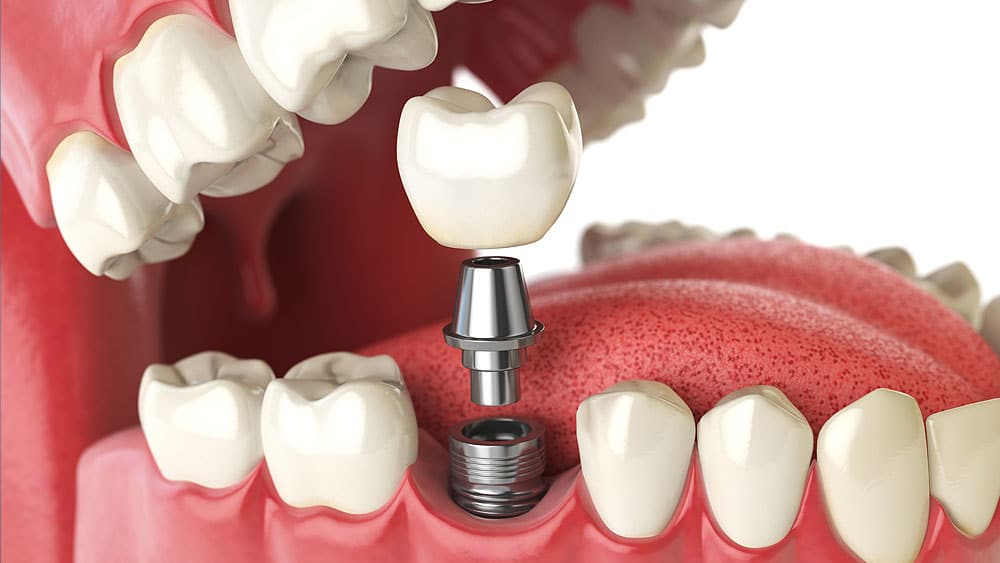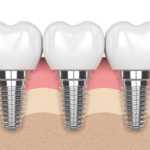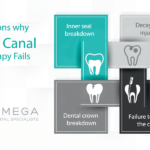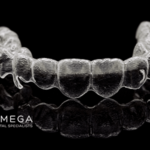A Complete guide to Single Tooth Implants in Houston, Texas

A dental implant is a post surgically inserted into your jawbone below the gum line. It serves as an attachment point for dental appliances such as a bridge or crown. It won’t come loose like dentures do, nor does it need to be anchored to neighboring teeth like a bridge. Dental implants are typically attached one at a time, when one tooth requires replacement. An orthodontic surgeon can then attach a tooth to the implant in a subsequent procedure.
Single tooth dental implants may the best option to give you the comfort and smile you’re looking for in Houston, TX. However, this procedure is more complex than getting a simple appliance and requires specialized training to place the implant properly the first time. The dentists you consider should be credentialed experts in dental implants to ensure they have specific training in this field.
All of the oral surgeons at Omega Dental Specialists are board certified in dental implants. Book an appointment with us today for a free consultation at no obligation.
Table of Contents
What is a single tooth dental implant?
One tooth dental implants includes the implant itself, an abutment and a restoration. The implant is a titanium post screwed into the upper or lower jawbone. The abutment connects to the implant with a screw and is shaped like a real tooth that’s been cut down. It may also be made of titanium, although it can also be made from gold or porcelain.
The restoration, commonly known as a crown, looks like the external portion of a natural tooth above the gum line. It’s typically composed of porcelain fused to a metal alloy (PFM), although it also can be metal or porcelain. The restoration can be cemented or screwed to the abutment, although a screw also requires the surgeon to fill the resulting hole with a tooth-colored restorative material known as dental filler.
Who should consider single-tooth dental implants?
Anyone who is missing one or more teeth should consider a single-tooth implant, but it requires enough bone in the jaw to attach the implant. This process is known as osseointegration, which occurs when living bone is directly connected to the implant. Osseointegration is essential for an implant to be mechanically stable, just as it is for prosthetics and artificial joints. Once this process is complete, the implant will act as the root for your new crown.
Your jaw needs to be strong enough to hold and support the implant, making it critical for your jaw to have adequate bone. Your oral surgeon may need to add more bone to your jaw with one of the bone augmentation procedures that are currently available. Furthermore, the natural teeth and other tissues surrounding the implant site must be in good health for you to tolerate an implant.
What is the process of single tooth implant?
The process for receiving a dental implant depends on many factors, especially the particular approach your dentist uses. However, it generally consists of the following phases:
- Consultation
- Bone augmentation
- Implant placement
- Healing cap
- Abutment and temporary crown
- Permanent crown
Some of these steps may be merged into a single procedure, while others may not be needed at all.
Consultation
Your initial consultation will typically be with a general dentist who has had training in implant placement and restoration or a prosthodontist who specializes in these techniques. Your consultation should include a comprehensive examination, during which your dentists will take your medical history, take X-rays and take impressions of your teeth. Your dentist may take a computed tomography (CT) scan of your mouth during this visit to determine if your jaw will require bone augmentation. These images will also identify structures your dentist will need to avoid during the surgical procedures.
Bone Augmentation
Your dentist will discuss the options for building up bone if your jaw doesn’t have enough bone for an implant. These options generally consist of either bone grafting or distraction.
Grafting is the process of adding bone from another source, including your own body. In this case, the surgeon will harvest bone from another location on your body, typically your chin, hip or mouth. Grafting can also use bone from external sources such as cadavers and animals. Synthetic materials like calcium phosphate and hydroxyapatite are also options for grafting. Bone distraction is a procedure that involves the use of pins and screws to slowly pull the bone apart at the surgical site, which causes your jaw to produce more bone. Bone augmentation requires 4 to 12 months before your jaw will be ready to accept an implant.
Implant Placement
Your prosthodontist or general dentist will make a plastic surgical guide to aid in the implant procedure. This guide fits over your existing teeth to indicate where the implant needs to go. The surgeon then places the implant into your jawbone where you have a missing tooth. A root-form implant is currently the most popular type and is so named because it will serve the root for the artificial tooth.
You’ll need to wait for the implant to become completely integrated with your jaw bone before you can proceed to the next stage. This process typically requires four to five months for the lower jaw and six to seven months for the upper jaw.
Healing Cap
The second surgery involves the placement of a collar, or healing cap, onto the implant. This round piece of metal will hold the gum away from the implant.
Your dentist will take an X-ray to confirm that osseointegration has completed. Once it has, your dentist will make an incision in the gum to expose the top of the implant and attach the healing cap to the implant. The healing cap will remain in place for 10 to 14 days, allowing your gum to heal. Your dentist may also place and adjust your removable partial denture, so you can use it during this period.
Abutment and Temporary Crown
Your surgeon will remove the healing cap once your gum heals and screw an abutment into the implant using special equipment and tighten it to ensure it won’t come loose. The next step is to take an impression of the abutment and place a temporary crown on the abutment. In some cases, your surgeon may place the abutment and temporary crown immediately after exposing the implant, meaning you won’t need a healing cap.
Your temporary crown will remain in place for four to six weeks while your gums heal around it. The temporary crown is softer than the permanent one, allowing it to cushion the implant while your jawbone gets stronger.
Permanent Crown
A dental laboratory will make your permanent crown while you’re wearing your temporary crown, based on the impression of your teeth and gums. This process typically takes two to three weeks, which is less time than your gums will need to heal from getting your temporary crown. Your dentist can attach the permanent crown with either cement or screws. Cement looks better since the crown won’t have a screw hole, but screws allow the dentist to remove the crown more easily. This may become necessary if your dentist ever needs to access the implant or surrounding tissue, typically for the purpose of making a repair.
How much does a single tooth implant cost?
A single tooth implant cost is quite variable, largely due to the highly personalized nature of our teeth. Recent changes in insurance plans may also affect the cost of dental implants in Houston. The average price for a single tooth implant without bone augmentation is typically between $1,800 and $5,000, as of 2018. However, the need for bone augmentation can result in a cost as high as $6,000. At the other extreme, a straightforward implant with no complicating factors could be as low as $1,500.
Another factor to consider when evaluating the lifetime cost of an implant is its longevity. Implants last much longer than any of the alternatives currently available, including bridges and crowns. These options will require replacement over time, which can eventually exceed the higher upfront cost of an implant.
How to care for your dental implants
Dental implants generally don’t require replacement, but there are a few things you can do to help ensure they last as long as possible.
For example, you should always practice good oral hygiene, but this becomes especially important when you have an implant. Brush twice a day with an interdental brush that can get between your teeth and clean around your implant. You should also floss once a day.
Visit your dentist every six months for cleanings and exams to ensure your implant stays in good condition. Avoid chewing hard things like ice and hard candy, which even break your natural teeth. Quit smoking, as tobacco can weaken your bone structure and increase the chances of your implant failing.
Financing
Most dental insurance plans now cover dental implants, although this isn’t universal since implants are still a comparatively new procedure. The circumstances regarding the loss of your tooth may be a factor in some cases, so you’ll still need to check with your insurance provider to find out if they cover implants. Even if your insurance plan generally covers implants, you may still be subject to an annual spending cap that prevents your provider from paying for the procedure. You’ll also need to talk to an administrator at your dentistry to determine if your insurance will be accepted.
You still have financing options available if your insurance doesn’t cover implants and you’re unable to pay for the procedure yourself. Omega Dental Specialists offers a variety of options for making low monthly payments on your implants, including third-party lenders and other credit programs. We accept most types of insurance, including Medicaid. We also accept payments by Clearing House Interbank Payments System (CHIPs), which is a private clearing house for large transactions in the United States.
What to expect
A single-tooth implant will function and feel like a natural tooth. It will also last up to 25 years, according to current studies. However, getting it to look like a natural tooth may be more difficult in some cases. This problem most often occurs when the surgeon has to set the implant at an angle to your jawbone because you don’t have enough bone for a straight placement. In these cases, the crown will need to be wider than usual to close the resulting space.
Where to get single tooth implants in Houston, TX
Convenient access is one factor that you may overlook when selecting a dentistry to get same day dental implants in Houston, Texas. Omega Dental Specialists is a state-of-the-art facility located in central Houston, between midtown and downtown.
We have completed thousands of dental implants, so we know how to maintain healthy smiles for our patients. We offer no-obligation consultations on dental implants and offer second opinions, so our patients have nothing to lose. Our surgeons are also board certified in a multiple specialties, including endodontics, orthodontics, oral surgery, orthodontics, pediatric dentistry and periodontics. These specialists are thus able to provide you and your family with complete dental care under one roof.
Make an appointment with us today to see if same day single tooth implants are right for you. We’re located at 106 W, Gray St. Houston, TX 77019, and our phone number is 713-322-7474. Our office hours are 9 am to 5 pm, Monday through Friday and 9 am to 3 pm on Saturday.





